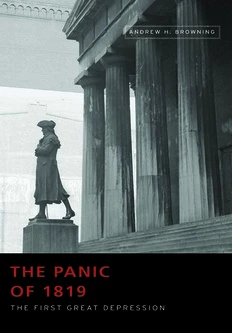
The Panic of 1819: The First Great Depression PDF
Preview The Panic of 1819: The First Great Depression
THE PANIC OF 1819 THE PANIC OF 1819 T H E F I R ST G R E AT D E P R E S S I O N ANDREW H. BROWNING UNIVERSITY OF MISSOURI PRESS Columbia Publication of this volume has been supported with a gift from the Kinder Institute on Constitutional Democracy Copyright © 2019 by The Curators of the University of Missouri University of Missouri Press, Columbia, Missouri 65211 Printed and bound in the United States of America All rights reserved. First printing, 2019. Library of Congress Cataloging-in-Publication Data Names: Browning, Andrew H., author. Title: The panic of 1819 : the first great depression / by Andrew H. Browning. Description: Columbia : University of Missouri Press, 2019. | Includes bibliographical references and index. | Identifiers: LCCN 2018043079 (print) | LCCN 2018044145 (ebook) | ISBN 9780826274250 (e-book) | ISBN 9780826221834 (hardcover : alk. paper) Subjects: LCSH: Depressions--History--19th century. | Financial crises--United States--History--19th century. | United States--Economic conditions--To 1865. | United States--Economic policy--To 1933. Classification: LCC HB3717 1819 (ebook) | LCC HB3717 1819 .B76 2019 (print) | DDC 330.973/054--dc23 LC record available at https://lccn.loc.gov/2018043079 This paper meets the requirements of the American National Standard for Permanence of Paper for Printed Library Materials, Z39.48, 1984. Typefaces: Bembo and Frutiger STUDIES IN CONSTITUTIONAL DEMOCRACY Justin B. Dyer and Jeffrey L. Pasley, Series Editors The Studies in Constitutional Democracy Series explores the origins and development of American constitutional and democratic traditions, as well as their applications and interpretations throughout the world. The often subtle interaction between constitutionalism’s commitment to the rule of law and democracy’s emphasis on the rule of the many lies at the heart of this enter- prise. Bringing together insights from history and political theory, the series showcases interdisciplinary scholarship that traces constitutional and demo- cratic themes in American politics, law, society, and culture, with an eye to both the practical and theoretical implications. Previous Titles in Studies in Constitutional Democracy Lloyd Gaines and the Fight to End Segregation James W. Endersby and William T. Horner Aristocracy in America: From the Sketch-Book of a German Nobleman Francis J. Grund Edited and with an Introduction by Armin Mattes From Oligarchy to Republicanism: The Great Task of Reconstruction Forrest A. Nabors John Henry Wigmore and the Rules of Evidence: The Hidden Origins of Modern Law Andrew Porwancher Bureaucracy in America: The Administrative State’s Challenge to Constitutional Government Joseph Postell The Myth of Coequal Branches: Restoring the Constitution’s Separation of Functions David J. Siemers CONTENTS Acknowledgments ix Introduction 3 Chapter One The Legacy of Napoleon: Embargo, War, and Peace 17 Chapter Two Three Revolutions: Market, Transportation, Corporation 49 Chapter Three Volcano Weather 75 Chapter Four Alabama Fever: “I Must Go West and Plant” 103 Chapter Five Bank Expansion: “Frothy Bubbles” 127 Chapter Six Bank Contraction: “The Axe Must Be Applied to the Root of the Evil” 157 Chapter Seven Hard Times in the East: “A Long Continuation of Distress” 183 Chapter Eight Hard Times in the West: “Reflections Which Almost Unmans Me” 217 Chapter Nine Relief? 251 Chapter Ten The Politics of Corruption and the Corruption of Politics 281 Chapter Eleven A House Dividing: The Panic of 1819 and the Growth of Sectionalism 321 Notes 361 Bibliography 395 Index 425 vii ACKNOWLEDGMENTS The idea behind this book gradually took shape over twenty years of teaching American history. I owe a debt of gratitude to my students in Oregon and Hawaii for their curiosity, interest, and good will. I also want to acknowl- edge my partners in teaching American studies over those years: the late Rosemary Stanberry, Kris Schuberg, and John Schlaefli. William Hausman and Clyde Haulman of the College of William and Mary offered valuable encouragement, as did Richard Scylla of NYU’s Stern School of Business. Daniel Dupre (UNC Charlotte) reviewed the completed manuscript and made thoughtful recommendations for which I am grateful. The book is better for all of their suggestions; any errors are my own. The staffs of a number of libraries and archives helped a great deal with tracking down obscure books, hard- to- find academic journals, and original manuscripts. I thank the kind librarians and clerks at the libraries of the Uni- versity of Arizona, Portland State University, the University of Washington, Princeton University, and the University of Virginia, as well as those of the National Archives and the Library of Congress Manuscript Division. During a stretch when I was a long way from any other library, the excellent staff of the Jefferson County Library on Washington’s Olympic Peninsula was par- ticularly helpful with my many interlibrary loan requests. The maps are the work of Chris Robinson. Those indicating the areas producing cotton and wheat are based on county- by- county statistics in the 1820 and 1840 censuses. My editors at the University of Missouri Press have made this a more read- able book in ways both large and small. I thank Mary Conley, Drew Griffith, and Barbara Smith- Mandell. In particular, Gary Kass has shown faith in this project from the start; I am more grateful to him than I can say. Most of all I want to thank my brother, Jim Browning, whose years of experience covering the stock market for the Wall Street Journal brought ix
